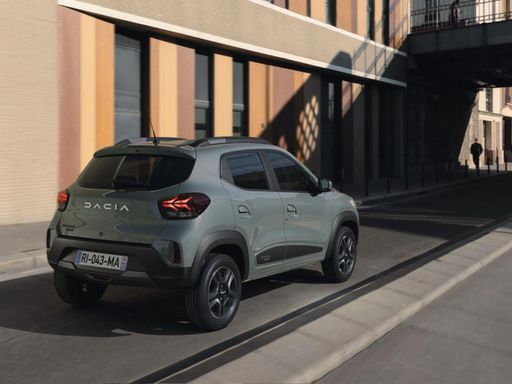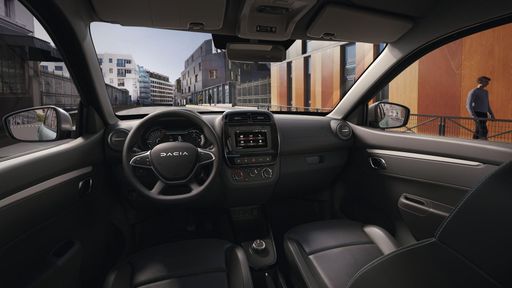Dacia Spring vs Nissan Micra – Which one offers the better deal?
Compare performance, boot capacity, efficiency and price at a glance.
Find out which car is the better choice for you – Dacia Spring or Nissan Micra?
Costs and Efficiency:
Looking at overall running costs, both models reveal some interesting differences in everyday economy.
Dacia Spring has a convincingly advantage in terms of price – it starts at 14500 £, while the Nissan Micra costs 24000 £. That’s a price difference of around 9506 £.
In terms of energy consumption, the advantage goes to the Dacia Spring: with 13.20 kWh per 100 km, it’s slight more efficient than the Nissan Micra with 14.20 kWh. That’s a difference of about 1 kWh.
As for range, the Nissan Micra performs convincingly better – achieving up to 416 km, about 188 km more than the Dacia Spring.
Engine and Performance:
Power, torque and acceleration are the classic benchmarks for car enthusiasts – and here, some clear differences start to show.
When it comes to engine power, the Nissan Micra has a significantly edge – offering 150 HP compared to 65 HP. That’s roughly 85 HP more horsepower.
In acceleration from 0 to 100 km/h, the Nissan Micra is significantly quicker – completing the sprint in 8 s, while the Dacia Spring takes 13.70 s. That’s about 5.70 s faster.
In terms of top speed, the Nissan Micra performs a bit better – reaching 150 km/h, while the Dacia Spring tops out at 125 km/h. The difference is around 25 km/h.
There’s also a difference in torque: Nissan Micra pulls clearly stronger with 245 Nm compared to 125 Nm. That’s about 120 Nm difference.
Space and Everyday Use:
Beyond pure performance, interior space and usability matter most in daily life. This is where you see which car is more practical and versatile.
Seats: Nissan Micra offers to a small extent more seating capacity – 5 vs 4.
In curb weight, Dacia Spring is convincingly lighter – 1013 kg compared to 1452 kg. The difference is around 439 kg.
In terms of boot space, the Nissan Micra offers slight more room – 326 L compared to 308 L. That’s a difference of about 18 L.
In maximum load capacity, the Nissan Micra performs minimal better – up to 1106 L, which is about 102 L more than the Dacia Spring.
When it comes to payload, Nissan Micra clearly perceptible takes the win – 408 kg compared to 302 kg. That’s a difference of about 106 kg.
Who wins the race?
The Nissan Micra proves to be is largely superior and therefore becomes our DriveDuel Champion!
Nissan Micra is the better all-rounder in this comparison.
Nissan Micra
Dacia Spring
The Dacia Spring stands out as an affordable and environmentally friendly option in the electric vehicle market, combining practicality with a compact design ideal for urban settings. Its minimalist interior, while basic, provides all the essential features needed for a comfortable drive, reflecting its cost-effective approach. The vehicle's performance suits city driving, making it an appealing choice for those seeking an entry-level electric car.
details @ dacia-presse.de
@ dacia-presse.de
 @ dacia-presse.de
@ dacia-presse.de
 @ dacia-presse.de
@ dacia-presse.de
Nissan Micra
The Nissan Micra is a compact hatchback renowned for its agile handling and city-friendly dimensions. With a design that blends sleek curves with a practical layout, it appeals to urban drivers who value style and efficiency. Inside, the car offers a surprising amount of room and useful tech features, making it both a convenient and comfortable ride for daily commutes.
details

|
|
|
|
|
Costs and Consumption |
|
|---|---|
|
Price
14500 - 17100 £
|
Price
24000 - 29900 £
|
|
Consumption L/100km
-
|
Consumption L/100km
-
|
|
Consumption kWh/100km
13.2 - 14.1 kWh
|
Consumption kWh/100km
14.2 - 14.7 kWh
|
|
Electric Range
225 - 228 km
|
Electric Range
317 - 416 km
|
|
Battery Capacity
26.80 kWh
|
Battery Capacity
40 - 52 kWh
|
|
co2
0 g/km
|
co2
0 g/km
|
|
Fuel tank capacity
-
|
Fuel tank capacity
-
|
Dimensions and Body |
|
|---|---|
|
Body Type
SUV
|
Body Type
Hatchback
|
|
Seats
4
|
Seats
5
|
|
Doors
5
|
Doors
5
|
|
Curb weight
1013 - 1050 kg
|
Curb weight
1452 - 1527 kg
|
|
Trunk capacity
308 L
|
Trunk capacity
326 L
|
|
Length
3701 mm
|
Length
3974 mm
|
|
Width
1583 mm
|
Width
1774 mm
|
|
Height
1519 mm
|
Height
1490 mm
|
|
Max trunk capacity
1004 L
|
Max trunk capacity
1106 L
|
|
Payload
265 - 302 kg
|
Payload
403 - 408 kg
|
Engine and Performance |
|
|---|---|
|
Engine Type
Electric
|
Engine Type
Electric
|
|
Transmission
Automatic
|
Transmission
Automatic
|
|
Transmission Detail
Reduction Gearbox
|
Transmission Detail
Reduction Gearbox
|
|
Drive Type
Front-Wheel Drive
|
Drive Type
Front-Wheel Drive
|
|
Power HP
44 - 65 HP
|
Power HP
122 - 150 HP
|
|
Acceleration 0-100km/h
13.7 - 19.1 s
|
Acceleration 0-100km/h
8 - 9 s
|
|
Max Speed
125 km/h
|
Max Speed
150 km/h
|
|
Torque
113 - 125 Nm
|
Torque
225 - 245 Nm
|
|
Number of Cylinders
-
|
Number of Cylinders
-
|
|
Power kW
33 - 48 kW
|
Power kW
90 - 110 kW
|
|
Engine capacity
-
|
Engine capacity
-
|
General |
|
|---|---|
|
Model Year
2024
|
Model Year
2026
|
|
CO2 Efficiency Class
A
|
CO2 Efficiency Class
A
|
|
Brand
Dacia
|
Brand
Nissan
|
What drive types are available for the Dacia Spring?
The Dacia Spring is available as Front-Wheel Drive.
The prices and data displayed are estimates based on German list prices and may vary by country. This information is not legally binding.
